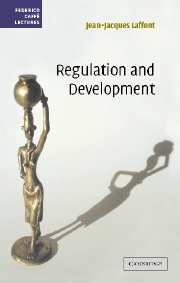Book contents
- Frontmatter
- Contents
- Publisher's acknowledgment
- Foreword
- Preface
- Introduction
- 1 Overview of regulatory issues
- 2 The rent extraction–efficiency trade-off
- 3 A positive theory of privatization
- 4 Enforcement, regulation, and development
- 5 Access pricing rules for developing countries
- 6 Universal service obligations in LDCs
- 7 Design of regulatory institutions in developing countries
- 8 Separation of regulatory powers and development
- 9 Concluding remarks
- References
- Index
8 - Separation of regulatory powers and development
Published online by Cambridge University Press: 05 June 2012
- Frontmatter
- Contents
- Publisher's acknowledgment
- Foreword
- Preface
- Introduction
- 1 Overview of regulatory issues
- 2 The rent extraction–efficiency trade-off
- 3 A positive theory of privatization
- 4 Enforcement, regulation, and development
- 5 Access pricing rules for developing countries
- 6 Universal service obligations in LDCs
- 7 Design of regulatory institutions in developing countries
- 8 Separation of regulatory powers and development
- 9 Concluding remarks
- References
- Index
Summary
Introduction
It is well recognized now that the design of proper institutions is crucial to development. Among the characteristics of governmental institutions, separation of powers stands as a cornerstone of democracy. Article 16 of the French Declaration of Human Rights of 1789 goes as far as saying “A society in which the guarantee of rights is not assured, nor the separation of powers provided for, has no constitution.” Indeed, since Montesquieu (1748), separation of powers has been explicitly recognized as vital:
Tout serait perdu si le même homme, ou le même corps des principaux et des nobles, ou du peuple, exerçaient les trois pouvoirs: celui de faire des lois, celui d'exécuter des résolutions publiques, et celui de juger les crimes ou les différents des particuliers.
(Montesquieu, 1748, p. 589)Hamilton and Madison in The Federalist Papers (Madison, Hamilton, and Jay, 1788) referred to Montesquieu as “the oracle who is always consulted and cited on this subject.” They put these principles into practice for the American Constitution within a broader view of checks and balances. It is only recently that economists have started modeling the value of separation of powers.
A first reason for duplicating regulation agencies is yardstick competition. Using the correlation of the signals obtained by these agencies enables the principal to extract in a costless way their information rents. This idea was modeled by Shleifer (1985) in the case of perfect correlation and Crémer and McLean (1988) in the case of an arbitrary degree of nonzero correlation.
- Type
- Chapter
- Information
- Regulation and Development , pp. 225 - 244Publisher: Cambridge University PressPrint publication year: 2005

